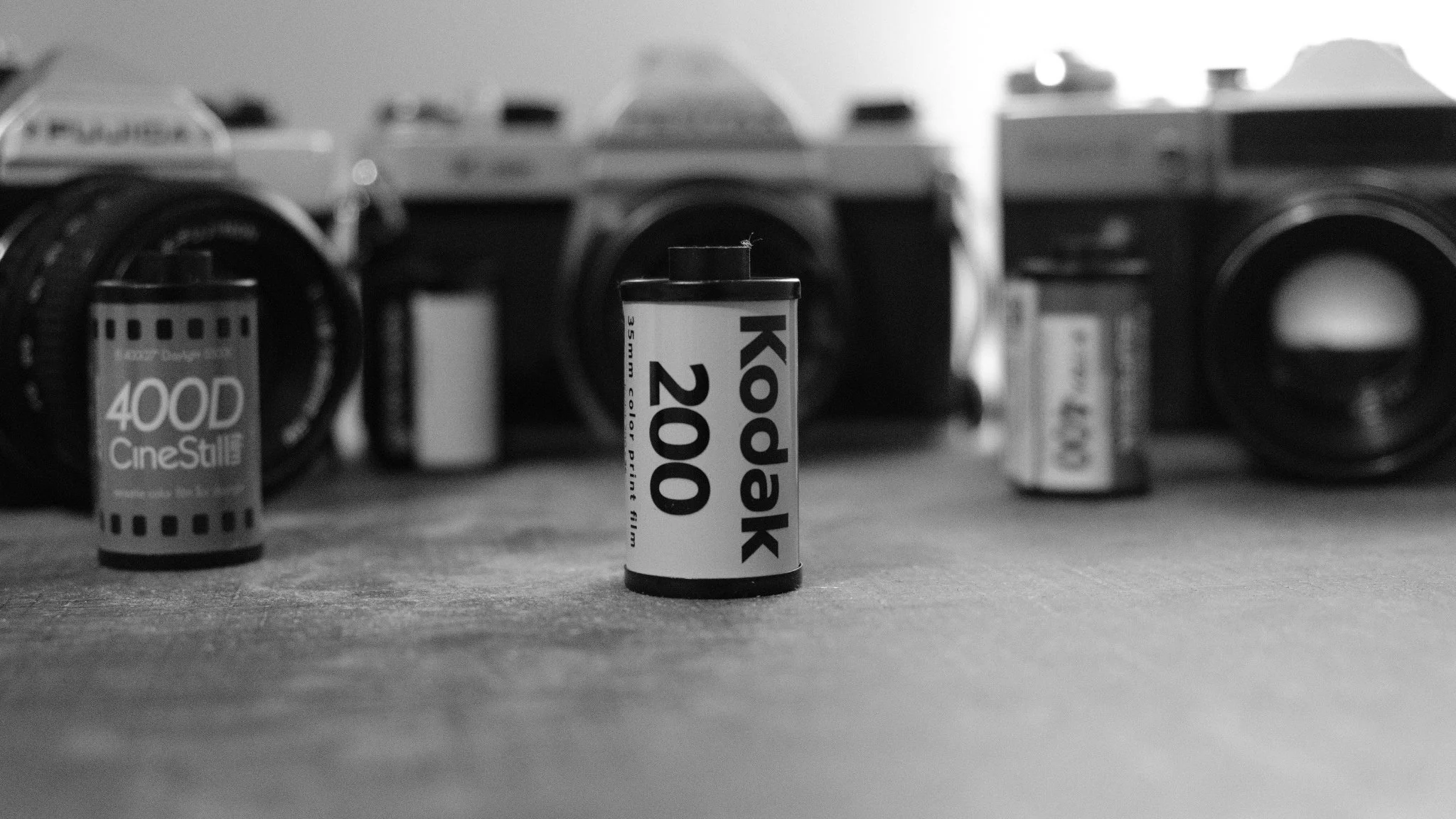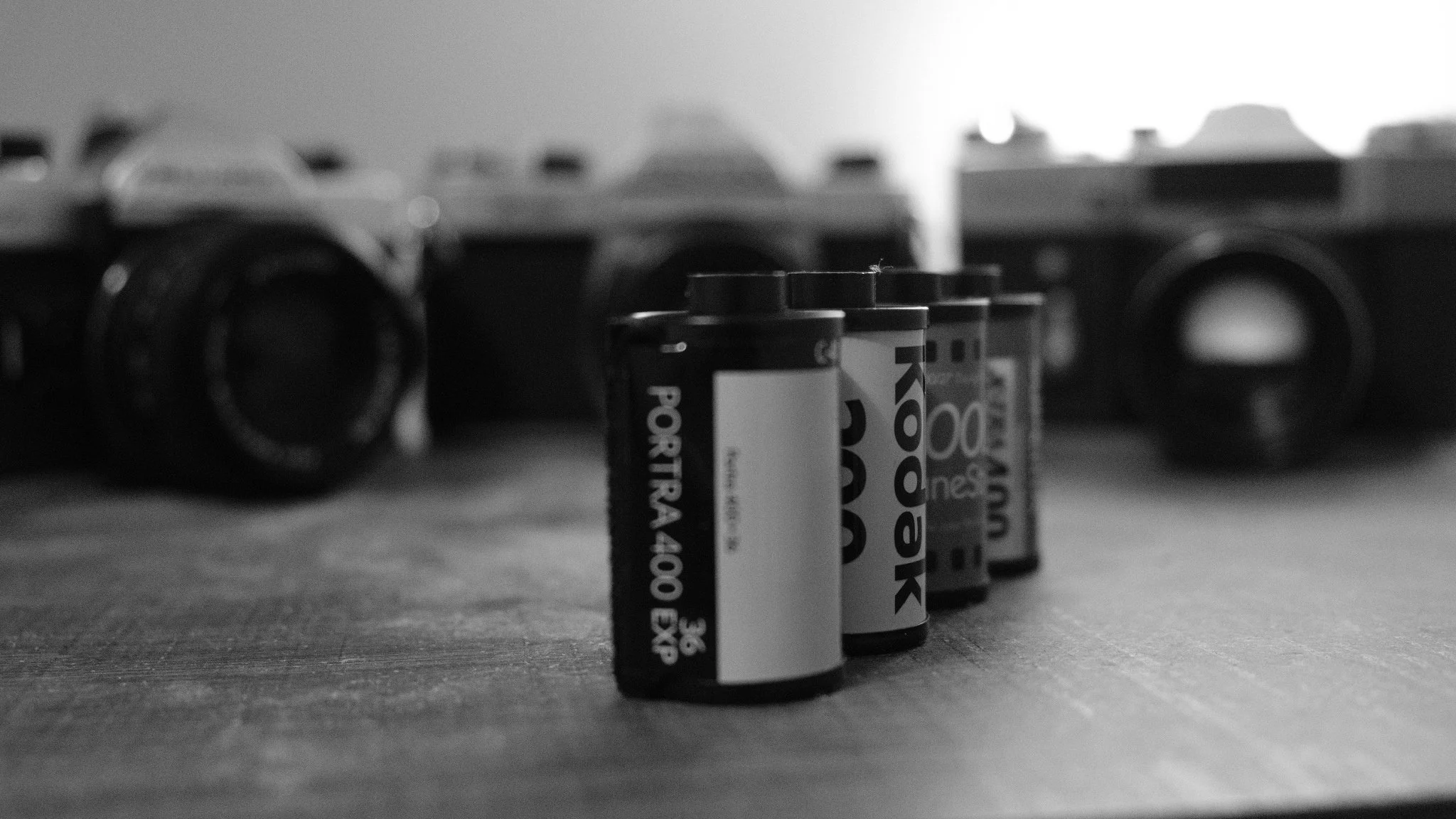beginners Guide to film photography
Film photography has made a comeback in recent years, and it's easy to see why. With its unique textures, rich colors, and nostalgic feel, there's something special about using a camera that doesn't rely on digital technology. If you’re new to film photography, Here’s a beginner’s guide to 35mm film Photography.
What is Film Photography?
Film photography is the process of capturing images on light-sensitive film, rather than digital sensors. When light hits the film through the camera lens, it creates a latent image that is later developed into a photograph. Unlike digital photography, where you can instantly see the results, film requires a longer process, adding to its charm and appeal.
Choosing Your Camera
The first step to getting started is selecting a film camera. There are 3 Main types to choose from:
SLR (Single-Lens Reflex) Cameras
Overview:
SLRs are among the most popular and versatile film cameras. They use a mirror mechanism that allows you to view exactly what the lens sees through the viewfinder. This type of camera is often favored by serious photographers due to its manual controls and high-quality lenses.
Pros:
Viewfinder Accuracy: You see exactly what the lens sees, making it easier to compose shots.
Interchangeable Lenses: You can swap lenses depending on your needs, offering flexibility for different shooting scenarios (e.g., wide-angle, portrait, macro).
Manual Control: SLRs offer complete control over settings like shutter speed, aperture, and focus, which gives you full creative freedom.
Better Image Quality: Typically, the larger body and advanced lenses result in higher image quality.
Cons:
Size & Weight: SLRs tend to be larger and heavier than other types of cameras, which can be cumbersome for casual use or travel.
Learning Curve: Due to the manual settings and controls, they can be difficult for beginners to master.
Cost: The price for both the camera body and lenses can be expensive, especially for higher-end models.
Point-and-Shoot Cameras
Overview:
Point-and-shoot cameras are compact, easy-to-use, and usually fully automatic. They typically have fixed lenses, which makes them smaller and simpler to operate than SLRs or rangefinders. These cameras are great for casual photography and quick snapshots.
Pros:
Simplicity: These cameras are very easy to use, often requiring little more than turning them on and pressing the shutter button. Perfect for beginners or those who want a hassle-free experience.
Compact & Lightweight: Point-and-shoots are small and portable, making them great for travel or everyday use.
Affordability: They are usually much cheaper than SLRs and rangefinders, making them a budget-friendly option.
Speed: These cameras are quick to operate, often featuring autofocus and automatic exposure control.
Cons:
Limited Control: You have little or no control over settings like shutter speed, aperture, or focus, which limits creative flexibility.
Fixed Lens: You can’t change the lens, which restricts your shooting options and overall creative potential.
Image Quality: While decent, the image quality may not be as high as an SLR or rangefinder, especially in low-light situations.
Rangefinder Cameras
Overview:
Rangefinder cameras have a unique focusing system, where you look through a separate window and use the rangefinder mechanism to align two images for focus. They tend to be more compact than SLRs but still offer good manual control.
Pros:
Compact Size: Rangefinders are usually smaller and lighter than SLRs, making them more portable.
Precise Focus: The rangefinder system allows for very accurate manual focusing, especially for portrait photography.
Quiet Operation: These cameras are generally quieter than SLRs since they don’t have a mirror that flips up, which can be ideal for discreet shooting.
Fast Operation: Rangefinders typically have fast, precise manual controls, which can make them great for street photography or capturing fast-moving subjects.
Cons:
No Through-the-Lens View: Unlike SLRs, you don't see through the lens to compose your shot, which can sometimes make framing more difficult.
Limited Lens Selection: Rangefinder cameras typically have fewer lens options compared to SLRs, and lenses can be more expensive.
Learning Curve: The manual focusing and lack of through-the-lens composition can take some getting used to, especially for beginners.
Expensive: High-quality rangefinder cameras, especially from brands like Leica, can be quite pricey.
Where to get them from?
You have 3 main options when it comes to getting a camera
Option 1: See if any Family members have got one
A great way to source a camera is to ask friends and family. You might get lucky and find that a family member owns one that they are not using anymore.
Option 2: Online Second hand Markets
Another way to get your hands on a camera is to simply look on private second hand markets like eBay.
Most sellers often don’t know what it is their selling as they probably found it in their grandads attic.
Because of this you can often find some really good Camera Equipment on ebay for Great prices.
One downside to this method is you can never be sure that the camera works. Sellers often don’t know how to test film cameras so they list them as parts or untested
Option 3: Refurbished
In my opinion the best way to buy a film camera is from a reputable online film camera shop.
The Experts in the shop would have checked and cleaned the camera so you can be Sure that it works. Most online camera shops have warranties on all their equipment too.
The one downside to this method is the cost of the camera will be a bit higher.
Spoiled for choice?
Want Specific camera recommendations?
Feel free to contact me for advice :)
Understanding Film Types
There are two main types of film: color negative film and black-and-white film. Color negative film is the most common and provides rich, vibrant colors, while black-and-white film offers classic monochrome images. Films come in different ISO (sensitivity to light) ratings, such as ISO 100, 200, 400, and even higher. A lower ISO (e.g., 100) is great for bright daylight, while a higher ISO (e.g., 800) works better in low light conditions.
Want Some beginner friendly film suggestions?
Loading the Film
Once you’ve got your camera and film, the next step is loading it into your camera. This process can vary slightly depending on the camera, but generally, you’ll open the back of the camera, insert the film roll, and pull the film leader into the take-up spool. Make sure to wind the film a few times to ensure it’s secure, then close the camera back.
Taking Photos
Film cameras can be manual or automatic. On manual cameras, you'll need to adjust settings like shutter speed, aperture, and focus. These settings control how much light enters the camera, how long the exposure lasts, and how sharp your image will be. If your camera is automatic, it will handle these settings for you, but you can still adjust things like focus and exposure compensation.
Don’t forget to advance the film after each shot—most cameras have a lever or dial to do this.
Developing Your Film
Once you’ve finished a roll of film, it’s time to develop it. You can take it to a lab, or if you’re feeling adventurous, you can develop the film yourself. Developing film involves chemicals that expose and fix the image onto the film strip. If you're just starting out, having a professional lab handle this step is the easiest option.
Scanning or Printing Your Photos
After developing, you’ll receive a set of negatives, which you can either have scanned to digital files or printed on photographic paper. Scanning gives you a digital version of your film shots that you can edit or share online.
Why Choose Film?
Film offers a unique, hands-on approach to photography. With fewer shots per roll, you’ll think more about each frame, leading to a more deliberate and creative process. Plus, the unpredictability of film results—whether it’s a slight light leak or grainy texture—gives each photo character.
MESSAGE from me
Starting with film photography is a fun and rewarding journey. Whether you’re drawn to the tactile experience or the nostalgic charm, there’s no better time to dive in. All it takes is a camera, some film, and a bit of curiosity to start capturing the world in a whole new way.
Thanks for taking the time to read this beginner’s guide to 35mm film photography
Feel free to contact me if you have any questions rel



